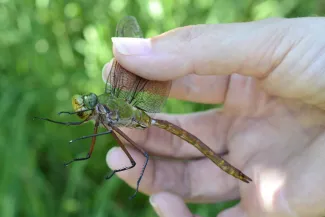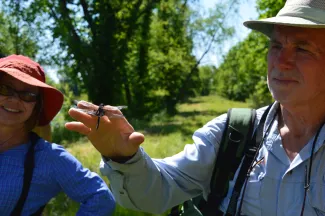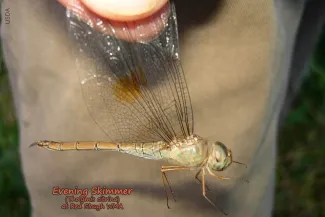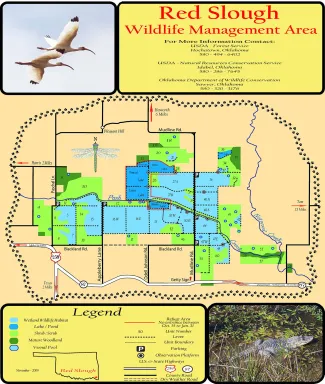The addition of dragonflies, with their splashy colors, delicate posture and relaxing flights, are welcome on nearly any wildlife-watching adventure. But the mosquitoes relentlessly buzzing the ears of wildlife enthusiasts may have a different opinion. To these pesky yet ecologically important insects, dragonflies are miniature attack helicopters with vicious weaponry.
With stout upper and lower lips and two pairs of included jaws, dragonflies are a force to be reckoned with, at least in the insect world. Almost any other flying insect is subject to a predatory look; dragonflies most often eat midges and mosquitoes, but will also capture butterflies, moths and even smaller dragonflies.

As adults, dragonflies spend most of their time on the wing; they hunt and capture their food while airborne, pursue mates, and even lay eggs in flight. In contrast to these aerial adults, immature dragonflies, or nymphs, are fully aquatic. Though water bound, these nymphs are equally as predatory as adults, preferring a lie-and-wait hunting style.
Fortunately for the mosquito-oppressed wildlife watcher, these winged fighters can be found in every corner of the state – as long as water is nearby. Oklahoma’s dragonfly and damselfly diversity is tremendous – at least 50 species have been documented in each county of the state! Two southeastern counties have even breached the 100 species mark. Two species were added to the Atoka County list last month, bringing that county's total to 101 odonate species. McCurtain County, home of Red Slough Wildlife Management Area, still reigns in terms of dragonfly and damselfly diversity with 119 documented species.
“If McCurtain County were a state, it would be ranked 26th in terms of dragonfly diversity,” said Brenda Smith-Patten, conservation biologist with the Oklahoma Biological Survey. “And 82 percent of McCurtain County’s diversity has been documented at Red Slough Wildlife Management Area.”
“The variety of habitats that are maintained and protected at the slough, paired with it falling within the Gulf Coastal Plains makes it a remarkable area in Oklahoma,” said Smith-Patten.
Eighty-seven species have been recorded on Red Slough WMA, a 5,814 acre area owned by the US Forest Service and cooperatively managed by the Wildlife Department. This total exceeds that of six U.S. state species lists. When combined with the Wildlife Department’s nearby Grassy Slough Wildlife Management Area, the regional species count goes up to 97 and tops that of 11 other U.S. state species lists.

Red Slough has produced five records for Oklahoma; the duckweed firetail, regal darner, two-striped forceptail, hyacinth glider and evening skimmer were all first spotted on the area.
“The sheer number of dragonfly species makes Red Slough and the surrounding area special, but it also contains at least 20 odonate species of conservation concern,” Smith-Patten said. “It's a veritable magical wonderland for dragonflies and critters of all sorts."
Chasing Dragons at Red Slough
As could be expected of any dragon hunt, chasing dragonflies at Red Slough WMA isn’t for the faint of heart. It requires patience, attention to detail, an attuned search image, and likely a lot of steps. (Capturing dragonflies at Red Slough WMA also requires a Scientific Collector’s permit from the Wildlife Department and a Special Use permit from the Ouachita National Forest. Permits are not required to photograph the winged fighters.)
For those willing to test their skills, David Arbour, biological aid for the Wildlife Department recommends the month of June. “That’s when we have the most dragonfly opportunities.” Even so, later visitors may have a greater chance of encountering unusual vagrants. “Strong southwest winds begin to blow southern and tropical dragonfly species northward in late August through October.”
These late winds propelled Arbour’s most exciting dragonfly find, an evening skimmer, to the area from the tropics.

“It was around seven in the morning in late August when I saw the skimmer flying close to the water with a bouncing flight. It was flying back and forth over a small pool of water in a drying canal,” Arbour said. “At the time, it was just the third record for the U.S. with previous records coming from south Texas and southern Florida.”
Arbour was able to capture and preserve the specimen for science.
Regardless of the timing of your visit, a camera will be a great addition to your field pack. Photographing dragonflies is not only a fun challenge, but is also a great way to help biologists document new species.
“I recommend using a telephoto lens of 200-300 mm over a macro lens for photographing dragonflies. Dragonflies can be very difficult to get close to, just like birds,” Arbour said. “By shooting from a little bit of distance, you can get the whole creature in focus. With a macro lens, you have to get closer, and will only be able to get part of the creature in focus.”
While any of Red Sloughs wetland units, lakes, ponds, or creeks can be a dragonfly magnet, Arbour suggests trying the dikes around Bittern Lake or Teal Lake. “I think these lakes offer the greatest dragonfly diversity.”

Plan your next Red Slough dragonfly adventure at wildlifedepartment.com or fs.usda.gov.